- Joined
- Dec 19, 2012
I ended up with this Cooler and thought I would post up some info on, my thought and performance from my perspective. I was kind of excited to try this radiator just because of the size as an AIO it's one of, if not the biggest available on the market. But first here's the official run down on the product from Alphacool
Product Information
With the Eisbaer, Alphacool is revolutionising the AIO cooler market. Classic AIO CPU coolers are disposable products that can’t be expanded or refilled. The Alphacool Eisbaer is built modularly and can be expanded, modified, or refilled at any time. That means the Eisbaer is not just an AIO, but is completely based on classic water cooling components. It’s quieter and more powerful than the average AIO solution.
The individual components
Radiator
Alphacool uses a radiator made of pure copper. The basis of the radiator is the popular Alphacool NexXxos series, which is globally renowned. The pure copper design increases the cooling performance enormously compared to the usual aluminium radiators found in classic AIOs. The thin fin thickness ensures impressive cooling performance with fans that have low RPMs. The Eisbaer’s performance also drops much slower when the fan power is lowered than radiators with higher fin thickness.
Tubing
Flexible PVC tubes make installing the Eisbaer easy. The tubing is easy to lay and get into the right position. Both tubes have anti-kink springs to prevent them from bending and cutting off the flow of water. Their 11/8mm size is also a standard in the water cooling field, and is a common size alongside the 13/10 and 16/10.
Quick Connectors
The Eisbaer was developed with expandability in mind. That’s why you’ll find a quick connector on one of the tubes. This quick connector is compatible with Alphacool HF Quick Connectors, making it easy to expand the cooling loop with a radiator and graphics card cooler.
Fans
The Eiswind fans were specially designed for use in radiators and provide very high static pressure to force cool air through the radiator’s cooling fins. Both fans can be regulated via PWM over an enormous range of 550 to 1700 RPM. A PWM Y-adapter is included with the Eisbaer, so both fans can be connected to a PWM connection on your motherboard or a separate fan controller.
Connectors
All connectors are based on the classic G1/4 inch threads, which are standard in the water cooling field. That means all the components can be switched out at any time if desired. So if you decide later that you’d rather have thicker tubing or even HardTubes, you can easily customise your system.
All these features make the Eisbaer cooler something really unique. Its high-quality aesthetic with an illuminated logo and reservoir – which is also where the pump is found – gives the inside of any PC a new shine. The soft-touch surface of the pump casing is another optical highlight.
With the Eisbaer, you get an all-around perfect product that is not only extremely powerful but can also run near-silently.
Pump
The basis of the pump is the Alphacool DC-LT Ceramic Ultra Low Noise pump, which is also available separately. The pump runs extremely quietly and can be regulated between 7 to 12V. You can also control the pump via your motherboard. If the Eisbaer is running on its own, running the pump at 7V won’t lower performance at all, as proven in many tests. The insulated pump casing reduces the noise generated and also almost entirely absorbs vibrations.
The smooth and glossy polished copper bottom of the cooler ensures optimal heat absorption and quickly and efficiently transfers heat to the water via the fine cross slot structure of the cooler.
Technical Details
Pump (Alphacool DC-LT 2600 Ultra low noise Ceramic)
Speed: 2600 RPM
Voltage: 7-13.5V DC
Power consumption: 4W
Maximum flow rate: 70L/h
Maximum head: 0.85m
Fan (Eiswind 14)
Bearing: sleeve bearing
Voltage: 12V
Power connection: 3-Pin
Rated speed: 1100 (+/- 10%)
Airflow: 62.31 cfm / 106 m3/h
Static pressure: 1.55 mmH20
Volume: 29.4 dB(A)
Scope of Delivery
1x Alphacool Eisbaer 420 CPU - Black
3x Eiswind Fan
1x Intel Backplate
1x Intel bracket
1x AMD bracket
PWM Adapter
Mounting material
1x Thermal paste
My first test was with the 10 core 7900X. I had previously established OC headroom with the EK Predator 360 XLC but did some re-testing with P95 ver.29.3 as you'll see 2 hours and 15 minutes at 4.5GHz with 1.25V. This was pushing the EK AIO right to its' edge but there wasn't any throttling either.

Then I swapped out the coolers and put the Eisbaer to the test. As you'll see within minutes it was over heated and throttling the CPU

I then proceeded to back things down.
4.3GHz with 1.2V was a fail
Down to 4.2GHz with 1.15V this was almost do-able but still signs of throttling after a couple of hours.

So I pretty much resigned myself to the fact that this big 420 AIO was only going to work well at stock settings on the 7900X with turb which lands it at 4.0 GHz

I also verified my TIM spread just to make sure that wasn't the issue. The 7900X has a fairly large IHS and needs the coverage to prform properly. Well that wasn't the proble either.

I appologize in advance I'll have to post these results later since the P95 pics aren't on my stick ATM.
But after the disappointing results with the 7900X I decided to lighten the load a bit and test it on my R5 1600x set up. My intention was to replace the Noctua D15 with the Eisbaer 420. Part of this was to see how well it would fit into the Phanteks Enthoo Luxe case. Initially I had wanted to put the Predator in this case but because of it's (the predators) design I wasn't able to make it work as it interfered with the 8 PIN CPU cable.
Now the Alphacool on the other hand would fit and being able to put the fans in the top of the case made for lots of room after installation.
Here's a few pics of the install
These are the nuts and bolts of it. The brackets need to be subassembled with the bolts springs and spacers. The assembly bolt is held in with a small nut on the bottom of the bracket.

The two halves of the hold down snap together in a recess on the bottom of the block/pump assembly

Since this PC was already exising, in order to fit the rad into place I needed to remove the front and slide it in through the cage area. You'll see the fans in the top waiting to be secured to the rad once in place.

Here's another area that the Eisbaer could use some improvement. I was only able to install it with the hoses at the back of the case. They wouldn't reach the CPU comfortably when oriented to the front. This necessitated removing my rear exhaust fan. Here it is all installed an running. The insignia on the block lights up a mild blue colour.

Here's where I'll add my testing results but I can tell you now that the Noctua D15 actually did a better job cooling the 1600X by a few degrees than the Eisbaer 420 did.
On this one I only tested for 30 minutes it was enough to get results. I already knew what the D15 could do from previous stability testing. Also to note the Ryzen platform still has a 20° offseton the "X" cpus so those temps aren't really as high as they seem.
Alphcool Eisbaer 420 after 30 minutes max temp was 80°C

And 30 minutes with the Noctua D15 max temp was 75.8°C

Overall I was surprised and extremely underwhelmed with the Alphacool Eisbaer 420. Mod my mods lists it at $152.50 Compared to the Noctua D15 at $89.95. The only place I feel the Eisbaer succeeds is in noise. The 1K fans are nearly inaudible and definitely quiter that the Noctua when it gets wound up.
As for where the Eisbaer is going wrong. I feel it's a combination of things. That's a big rad to push liquid through, the small hoses and the weak pump are really showing their limits here.
Comparing this to the EX predator well there is no comparison. First of all it's $100 more but the benefits I think will speak for themselves. Ek p[uts it all in the with large hoses their tried heatkiller CPU block, and the big hitter is the liang DDC 3.1 pump which is almost a standard these days.
Overall the Alphacool is working and keeping my HTPC cool but honestly for the price/performance I really wouldn't recommend it to anyone.
- - - Updated - - -
I'll have to fix this later. Somehow my pics got all messed up
Product Information
With the Eisbaer, Alphacool is revolutionising the AIO cooler market. Classic AIO CPU coolers are disposable products that can’t be expanded or refilled. The Alphacool Eisbaer is built modularly and can be expanded, modified, or refilled at any time. That means the Eisbaer is not just an AIO, but is completely based on classic water cooling components. It’s quieter and more powerful than the average AIO solution.
The individual components
Radiator
Alphacool uses a radiator made of pure copper. The basis of the radiator is the popular Alphacool NexXxos series, which is globally renowned. The pure copper design increases the cooling performance enormously compared to the usual aluminium radiators found in classic AIOs. The thin fin thickness ensures impressive cooling performance with fans that have low RPMs. The Eisbaer’s performance also drops much slower when the fan power is lowered than radiators with higher fin thickness.
Tubing
Flexible PVC tubes make installing the Eisbaer easy. The tubing is easy to lay and get into the right position. Both tubes have anti-kink springs to prevent them from bending and cutting off the flow of water. Their 11/8mm size is also a standard in the water cooling field, and is a common size alongside the 13/10 and 16/10.
Quick Connectors
The Eisbaer was developed with expandability in mind. That’s why you’ll find a quick connector on one of the tubes. This quick connector is compatible with Alphacool HF Quick Connectors, making it easy to expand the cooling loop with a radiator and graphics card cooler.
Fans
The Eiswind fans were specially designed for use in radiators and provide very high static pressure to force cool air through the radiator’s cooling fins. Both fans can be regulated via PWM over an enormous range of 550 to 1700 RPM. A PWM Y-adapter is included with the Eisbaer, so both fans can be connected to a PWM connection on your motherboard or a separate fan controller.
Connectors
All connectors are based on the classic G1/4 inch threads, which are standard in the water cooling field. That means all the components can be switched out at any time if desired. So if you decide later that you’d rather have thicker tubing or even HardTubes, you can easily customise your system.
All these features make the Eisbaer cooler something really unique. Its high-quality aesthetic with an illuminated logo and reservoir – which is also where the pump is found – gives the inside of any PC a new shine. The soft-touch surface of the pump casing is another optical highlight.
With the Eisbaer, you get an all-around perfect product that is not only extremely powerful but can also run near-silently.
Pump
The basis of the pump is the Alphacool DC-LT Ceramic Ultra Low Noise pump, which is also available separately. The pump runs extremely quietly and can be regulated between 7 to 12V. You can also control the pump via your motherboard. If the Eisbaer is running on its own, running the pump at 7V won’t lower performance at all, as proven in many tests. The insulated pump casing reduces the noise generated and also almost entirely absorbs vibrations.
The smooth and glossy polished copper bottom of the cooler ensures optimal heat absorption and quickly and efficiently transfers heat to the water via the fine cross slot structure of the cooler.
Technical Details
Pump (Alphacool DC-LT 2600 Ultra low noise Ceramic)
Speed: 2600 RPM
Voltage: 7-13.5V DC
Power consumption: 4W
Maximum flow rate: 70L/h
Maximum head: 0.85m
Fan (Eiswind 14)
Bearing: sleeve bearing
Voltage: 12V
Power connection: 3-Pin
Rated speed: 1100 (+/- 10%)
Airflow: 62.31 cfm / 106 m3/h
Static pressure: 1.55 mmH20
Volume: 29.4 dB(A)
Scope of Delivery
1x Alphacool Eisbaer 420 CPU - Black
3x Eiswind Fan
1x Intel Backplate
1x Intel bracket
1x AMD bracket
PWM Adapter
Mounting material
1x Thermal paste
My first test was with the 10 core 7900X. I had previously established OC headroom with the EK Predator 360 XLC but did some re-testing with P95 ver.29.3 as you'll see 2 hours and 15 minutes at 4.5GHz with 1.25V. This was pushing the EK AIO right to its' edge but there wasn't any throttling either.
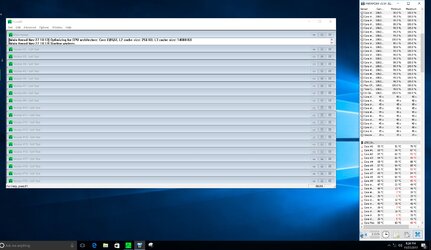
Then I swapped out the coolers and put the Eisbaer to the test. As you'll see within minutes it was over heated and throttling the CPU
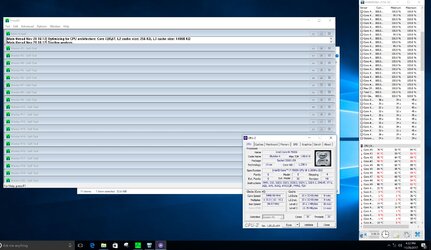
I then proceeded to back things down.
4.3GHz with 1.2V was a fail
Down to 4.2GHz with 1.15V this was almost do-able but still signs of throttling after a couple of hours.
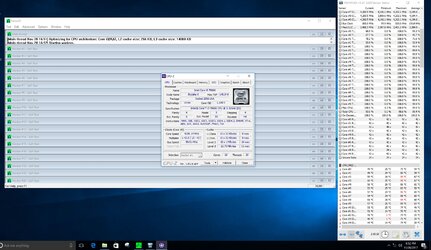
So I pretty much resigned myself to the fact that this big 420 AIO was only going to work well at stock settings on the 7900X with turb which lands it at 4.0 GHz
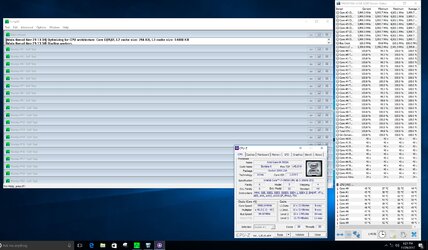
I also verified my TIM spread just to make sure that wasn't the issue. The 7900X has a fairly large IHS and needs the coverage to prform properly. Well that wasn't the proble either.
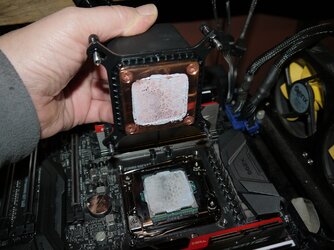
I appologize in advance I'll have to post these results later since the P95 pics aren't on my stick ATM.
But after the disappointing results with the 7900X I decided to lighten the load a bit and test it on my R5 1600x set up. My intention was to replace the Noctua D15 with the Eisbaer 420. Part of this was to see how well it would fit into the Phanteks Enthoo Luxe case. Initially I had wanted to put the Predator in this case but because of it's (the predators) design I wasn't able to make it work as it interfered with the 8 PIN CPU cable.
Now the Alphacool on the other hand would fit and being able to put the fans in the top of the case made for lots of room after installation.
Here's a few pics of the install
These are the nuts and bolts of it. The brackets need to be subassembled with the bolts springs and spacers. The assembly bolt is held in with a small nut on the bottom of the bracket.
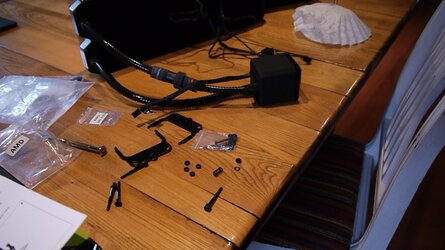
The two halves of the hold down snap together in a recess on the bottom of the block/pump assembly
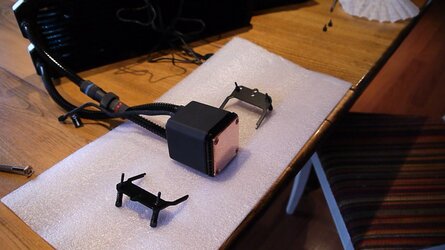
Since this PC was already exising, in order to fit the rad into place I needed to remove the front and slide it in through the cage area. You'll see the fans in the top waiting to be secured to the rad once in place.
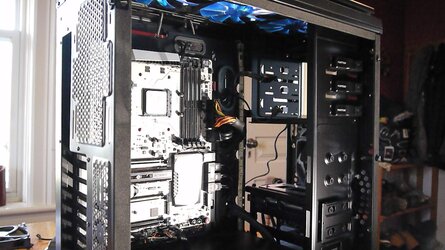
Here's another area that the Eisbaer could use some improvement. I was only able to install it with the hoses at the back of the case. They wouldn't reach the CPU comfortably when oriented to the front. This necessitated removing my rear exhaust fan. Here it is all installed an running. The insignia on the block lights up a mild blue colour.
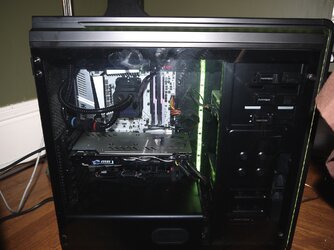
Here's where I'll add my testing results but I can tell you now that the Noctua D15 actually did a better job cooling the 1600X by a few degrees than the Eisbaer 420 did.
On this one I only tested for 30 minutes it was enough to get results. I already knew what the D15 could do from previous stability testing. Also to note the Ryzen platform still has a 20° offseton the "X" cpus so those temps aren't really as high as they seem.
Alphcool Eisbaer 420 after 30 minutes max temp was 80°C
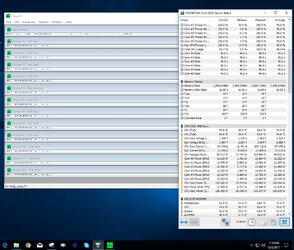
And 30 minutes with the Noctua D15 max temp was 75.8°C
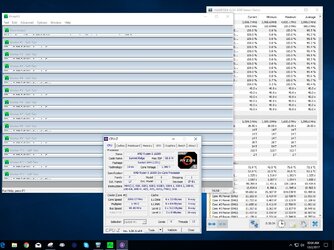
Overall I was surprised and extremely underwhelmed with the Alphacool Eisbaer 420. Mod my mods lists it at $152.50 Compared to the Noctua D15 at $89.95. The only place I feel the Eisbaer succeeds is in noise. The 1K fans are nearly inaudible and definitely quiter that the Noctua when it gets wound up.
As for where the Eisbaer is going wrong. I feel it's a combination of things. That's a big rad to push liquid through, the small hoses and the weak pump are really showing their limits here.
Comparing this to the EX predator well there is no comparison. First of all it's $100 more but the benefits I think will speak for themselves. Ek p[uts it all in the with large hoses their tried heatkiller CPU block, and the big hitter is the liang DDC 3.1 pump which is almost a standard these days.
Overall the Alphacool is working and keeping my HTPC cool but honestly for the price/performance I really wouldn't recommend it to anyone.
- - - Updated - - -
I'll have to fix this later. Somehow my pics got all messed up
Last edited: